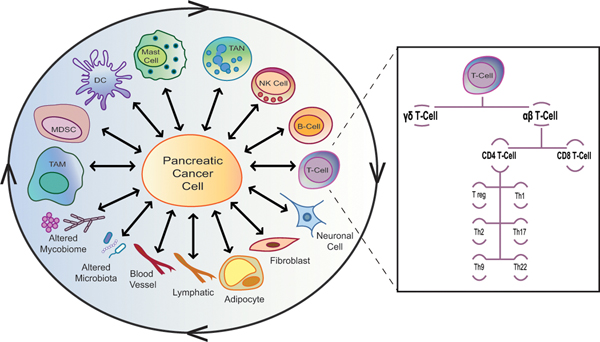FIGURE 2.

Pancreatic cancer stroma is a well-organized, dynamic and complex system.
Pancreatic cancer stroma is made up of diverse cellular types, including immune cells, fibroblasts, adipocytes, neuronal cells, blood vessels and lymphatics. Also, a wide range of immune cellular populations commonly infiltrate pancreatic cancers. These include tumor-associated macrophages (TAMs), dendritic cells (DCs), myeloid-derived suppressor cells (MDSCs), tumor-associated neutrophils (TANs), natural killer (NK) cells, T cells, B cells, innate lymphoid cells (ILCs) and mast cells. Many of these stromal cell types involve several specialized types and subtypes that exhibit distinct molecular and functional activity profiles, including T cells. Conventional T lymphocytes express TCRs on their surface that are composed of α and β chains (αβ T cells). αβ T cells are generally either CD4+ (T helper cells; Th cells) or CD8+ (T cytotoxic lymphocytes; CTL). When naïve CD4+ T cells get activated, they differentiate into very distinct Th subsets, including Th1, Th2, Th17, Treg, Th9 and Th22. In addition to αβ T cells, some T lymphocytes express γ and δ TCR chains (γδ T cells). All these stroma components continuously interact with each other and with cancer cells, creating a very dynamic and complex stromal-cancer crosstalk network.
